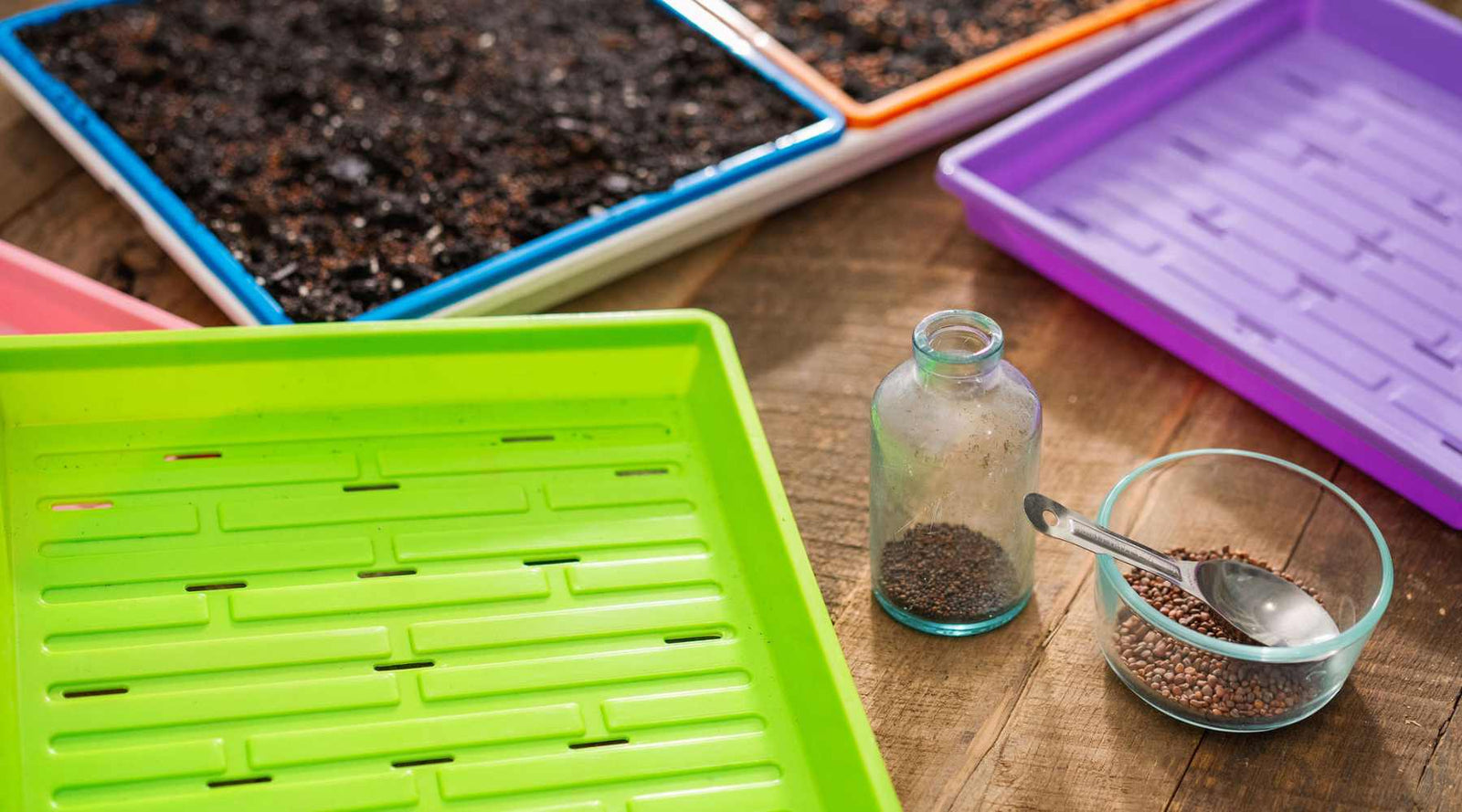Free Shipping on Orders over $75 to the Contiguous US
Free Shipping on Orders over $75 to the Contiguous US
How and When to Use 10x10 Microgreen Trays to Grow Nutrient-Packed Greens
May 15, 2025 5 min read 0 Comments

Growing microgreens can be a fun and rewarding activity. With the use of 10x10 microgreen trays, anyone can grow these nutritious greens in the comfort of their own home, even in the smallest spaces. This comprehensive guide will provide you with all the information you need to successfully grow microgreens and enjoy their numerous health benefits.
What are Microgreens?
Microgreens are young, edible plants that are harvested at the early stages of their growth, usually just after the first true leaves have formed. They are packed with nutrients and can be used in a variety of dishes, such as salads, sandwiches, and smoothies. Microgreens come in a variety of flavors and colors, making them an attractive and healthy addition to any meal.

Why Choose 10x10 Microgreen Trays?
1010 microgreen trays are perfect for those who want to grow microgreens in a small space, such as a windowsill or countertop. These trays are compact and easy to manage, allowing you to grow a variety of microgreens without taking up too much space. Additionally, 10x10 trays are a more affordable option for those who are just starting out or want to experiment with different types of microgreens.
Getting Started with 1010 Microgreen Trays
Choosing the Right Tray
When selecting a 1010 microgreen tray, opting for a heavy-duty, reusable tray made from food-safe plastic is key to ensuring durability and ease of cleaning for long-term use. Having both trays with holes and trays without holes offers flexibility in managing moisture levels during the growing process, allowing for proper drainage and efficient bottom watering.

Shallow vs. Deep Trays
1010 trays are available in both shallow and deep options, and both are excellent for growing microgreens. Shallow trays work well for crops that grow quickly and don’t require extensive root space, such as microgreens and small herbs. Their lower profile allows for easy harvesting and efficient stacking. Deep trays, on the other hand, provide more room for root development, making them ideal for larger or longer-growing crops, as well as for crops that benefit from increased moisture retention. Choosing between shallow and deep trays depends on your crop type and growing preferences, but both options are versatile and dependable for microgreen production.

Selecting the Best Microgreen Seeds
There are a wide variety of microgreen seeds available, and choosing the right ones for your needs depends on your personal preferences as well as the space you have available. Some popular microgreen seeds include:
- Broccoli seeds
- Kale seeds
- Pea seeds
- Arugula seeds
- Radish seeds
- Amaranth seeds
- Chia seeds
- Mustard seeds
- Beet seeds
- Buckwheat seeds
For more information on the Top Ten Microgreens to Grow check out this article.

Preparing the Growing Medium
Microgreens can be grown on a variety of growing mediums, such as soil, coconut coir, or grow mats made from natural fibers like hemp or jute. To prepare the growing medium, soak it in water and place it into the 10x10 tray with holes. The growing medium should be moist but not saturated.
Check out our article on the Top 5 Best Growing Mediums for Microgreens to learn more.

Planting the Seeds
After preparing the growing medium, evenly distribute the microgreen seeds across the surface. It's essential not to overcrowd the seeds, as this can lead to issues with mold and uneven growth. Once the seeds are evenly distributed, lightly mist them with water to help with germination.
Germinating the Seeds
Cover the seeded 10x10 tray with another tray without holes or a humidity dome to create a dark, moist environment for germination. Place the tray in a warm area, ideally between 65°F and 75°F. Check on the seeds daily, and mist with water as needed to keep the growing medium moist. Most microgreen seeds will begin to germinate within 3-5 days.

How Can I Grow Microgreens in the Smallest Space?
Maximizing Space with Vertical Racks
If you have limited space for growing microgreens, consider using vertical racks to stack multiple 10x10 trays. This allows you to grow more microgreens in a smaller area and can help increase air circulation, reducing the risk of mold and other issues.
Utilizing Windowsills and Countertops
Windowsills and countertops can be great places to grow microgreens in small spaces. Place your 10x10 trays near a window that receives plenty of sunlight, or use supplemental lighting if natural light is limited.
Rotating Trays for Continuous Harvest
To ensure a continuous supply of microgreens, consider rotating trays on a regular basis. When one tray is ready to harvest, start a new tray with fresh seeds. This will help you maintain a steady supply of microgreens while maximizing the use of your available space.

Caring for Your Microgreens
Proper Watering Techniques
Watering microgreens correctly is crucial for their growth and health. Bottom-watering is the recommended method, as it ensures even coverage and reduces the risk of mold and rot. To bottom-water your microgreens, simply pour water into the tray without holes and place the tray with holes and growing medium on top. The growing medium will absorb the water, providing the microgreens with the moisture they need.
Monitoring Light and Temperature
Microgreens require a consistent environment to grow properly. Ensure that your growing area has a consistent temperature between 65°F and 75°F and that your microgreens receive adequate light. If natural light is limited, consider using supplemental lighting, such as LED grow lights.
Harvesting Your Microgreens
Microgreens are typically ready to harvest when they reach 2-3 inches in height, usually within 10-14 days of planting. To harvest, simply use a pair of clean scissors to cut the microgreens just above the growing medium. Rinse the harvested greens and enjoy them in your favorite dishes.

Troubleshooting Common Microgreen Issues
Mold and Fungi
Mold and fungi can be common issues when growing microgreens. To prevent these problems, ensure proper air circulation, avoid overcrowding seeds, and use the bottom-watering method. If mold or fungi do appear, remove the affected microgreens and adjust your growing conditions to prevent future issues.
Leggy or Weak Microgreens
If your microgreens appear leggy or weak, it may be due to insufficient light or overcrowding. Ensure that your microgreens receive adequate light and that seeds are not planted too densely.
10x10 Microgreen Tray FAQ
When is the best time to harvest my 10x10 microgreen tray?
Microgreens are usually ready to harvest after 2 to 3 weeks. Harvest when you see the first set of true leaves.
How do I properly clean my 10x10 microgreen tray?
Sanitizing your microgreen tray will decrease the risk of mold and contamination. We’ve had success using a peroxide dilution in a spray. Simply spray all sides and parts of your microgreen trays and then allow to air dry. Read more about cleaning propagation trays in this article on How to Wash and Care for Seedling Trays.
How can I extend the life of my 10x10 microgreen tray?
To extend the life of your 10x10 microgreen tray, properly clean trays and store away from direct sunlight.
Conclusion
Growing microgreens in 10x10 trays is an excellent way to enjoy these nutrient-packed greens in the smallest of spaces. With proper care and attention, you can successfully grow a variety of microgreens and enjoy their numerous health benefits. By following the tips and guidelines provided in this comprehensive guide, you'll be well on your way to growing delicious and nutritious microgreens in your own home.
Featured Products
Subscribe
Sign up to get the latest on sales, new releases and more …
